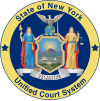|
New York Family Court
The Family Court of the State of New York is a specialized court of the New York State Unified Court System located in each county of the state.[2][3][4] The New York City Family Court is the name given to the state Family Court within New York City. JurisdictionIt is a family court that hears cases involving children and families and handles issues such as child abuse and neglect, adoption, child custody and visitation, domestic violence, guardianship, juvenile delinquency, paternity, persons in need of supervision (PINS), child support, and termination of parental rights.[5][6] In New York City, it has concurrent jurisdiction with the New York City Criminal Court for family offenses (domestic violence).[citation needed]  Family Court does not have jurisdiction over divorces, which must be litigated in the Supreme Court (which is a trial court, rather than the highest court which would be the New York Court of Appeals) and although Criminal Court domestic violence parts typically hear all cases involving crimes against intimate partners (whether opposite- or same-sex), New York law defines family offenses to include only those related by blood, actual marriage (common law marriage is not recognized in New York), or a child in common.[citation needed] Unlike ordinary trial courts, there is no jury in family court. The cases are heard and decided by a judge. The aim of family court is to make decisions in the best interests of the child.[7] PersonnelJudgesIn the New York City Family Court (the "Family Court of the State of New York within the City of New York"), judges are appointed by the Mayor to ten-year terms; elsewhere they are elected to ten-year terms.[2] There are 47 judges in the New York City Family Court.[8] In 1939, Justice Jane Bolin became the first black female judge in the United States when Mayor Fiorello La Guardia swore her in to the bench of the Family Court, then called the Domestic Relations Court.[citation needed] Her 10-year appointment was renewed by the city's mayors three times until she reached the mandatory retirement age of 70.[citation needed] OtherReferees hear custody, visitation, orders of protection, and foster care cases; private attorneys, judicial hearing officers, or court attorneys may be appointed.[9][10][11] Judicial Hearing Officers (JHOs) hear some family offense, custody, visitation, adoption, and voluntary placement foster care cases.[12] Support magistrates hear support cases (petitions filed seeking support for a child or spouse) and paternity cases (petitions filed requesting the court to enter an order declaring someone to be the father of a child).[9] History
The NYC Domestic Relations part (commonly known as the Family Court) of the Magistrates' Court system created in 1910 had dealt with those chargeable with the support of wives, children and "poor relatives" under its criminal jurisdiction over "disorderly persons".[13][14] The children's court part of the NYC Court of Special Sessions was created in 1915, from a 1902 children's court division of the New York County Court of General Sessions.[15] Children's courts were authorized throughout the state by constitutional referendum in 1921 followed by statutes in 1922 and 1924.[16][17][18][19] By 1933, jurisdiction was divided among the children's court, the magistrates' courts which dealt with deserting and nonsupporting husbands as "disorderly", the court of special sessions with jurisdiction in illegitimacy cases, the surrogate's court with jurisdiction in adoption cases, and the supreme court with divorce jurisdiction.[20] The NYC Children's Court and NYC Domestic Relations Court (commonly known as the Family Court) were consolidated into the Domestic Relations Court of the City of New York created on October 1, 1933.[21][22][19] In 1962 the Family Court replaced these courts after a 1961 constitutional amendment.[1][23] See also
Notes
References
External links
|
||||||||||||||||||
